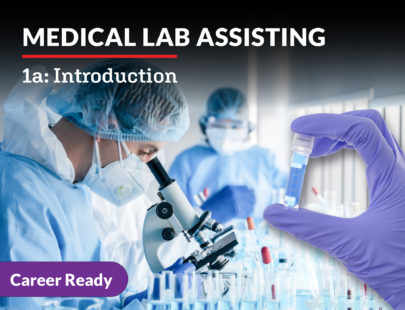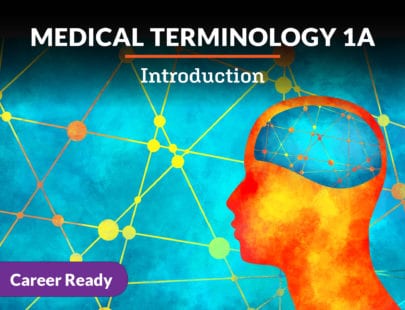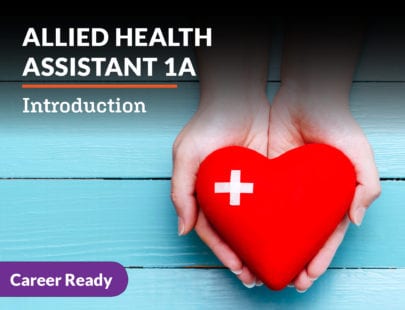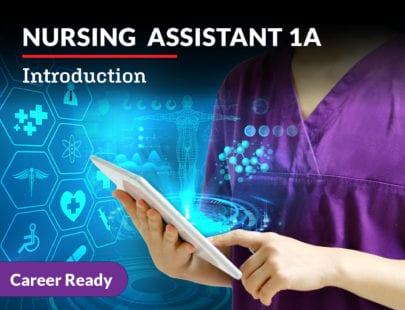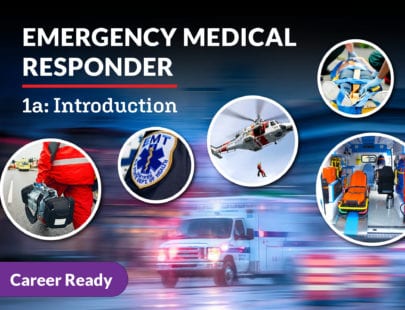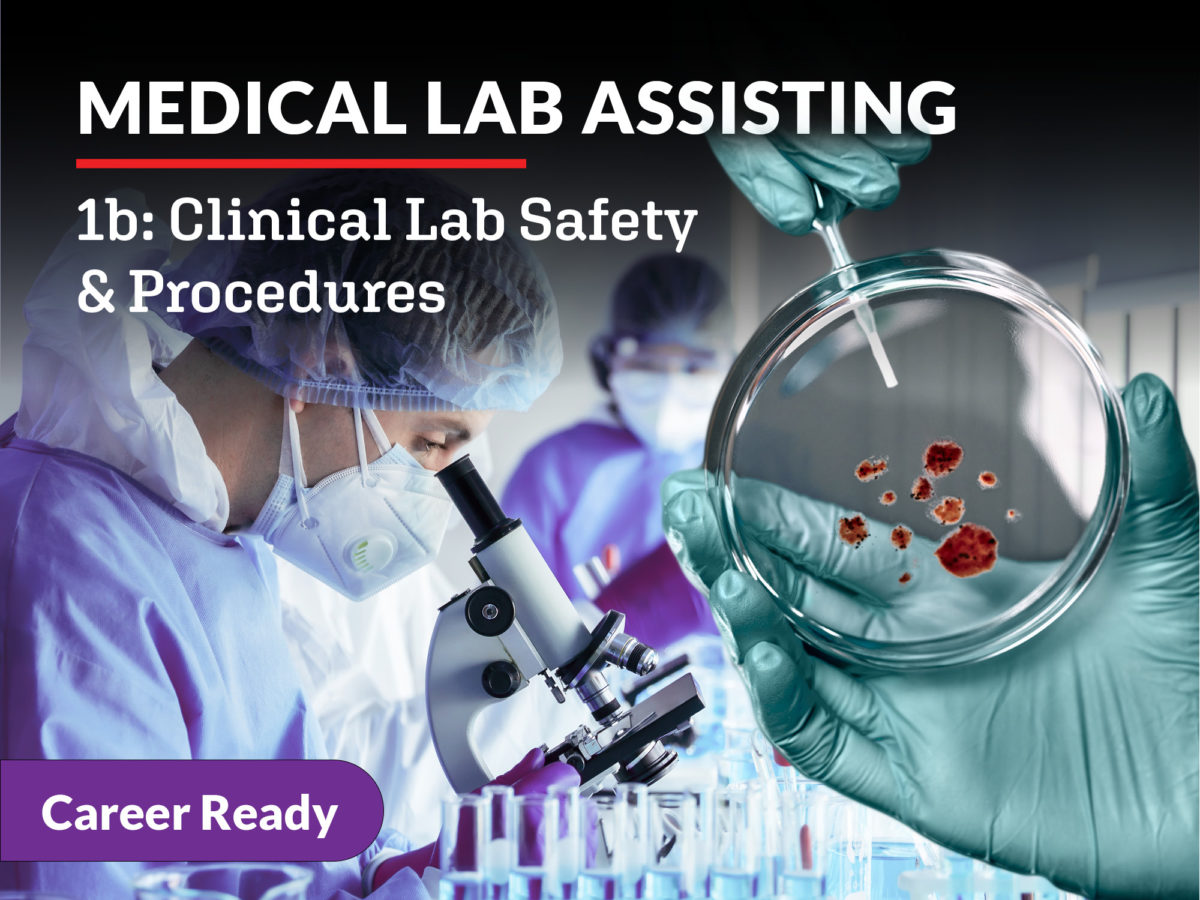
Medical Lab Assisting 1b: Clinical Lab Safety & Procedures
You’ve pulled back the patient curtain and have learned the basics of the world of a medical assistant. Now, it’s time to dig deeper and peer into the anatomy of the role so you can determine which type of medical assistant best suits you. In this course, you will learn more about patient care and procedures, testing and care coordination, pharmacology and safety, reimbursement, and the law. You will also narrow your own areas of interest, research organizations to shadow, and ultimately prepare for certification. Throw that curtain wide open, and let’s continue the pursuit of a medical assistant!
Units at a Glance
Unit 1: Clinical Lab Procedures for MLAs
When you step into a laboratory, you are surrounded by technology that has taken generations to develop. The hours spent perfecting the tools of the lab are evident from the microscopes to the beakers to the test strips. In the hands of trained laboratory personnel, these tools have led to medical breakthroughs that have cured diseases and extended human life. Learning how to perform the procedures of the laboratory is the first step in becoming part of this legacy. History is being made right now, so let’s jump in!
What will you learn in this unit?
- Identify the departments that make up the medical laboratory
- Discuss testing and troubleshooting blood samples in the medical laboratory
- Summarize the use of glassware, pipettes, and testing supplies in the lab
- Describe the features and functions of microscopes and centrifuges
- Explain the purpose and mechanisms behind common POCTs
Unit 2: Aseptic Technique and Sterilization
Can you imagine surgeons not washing their hands before surgery? How would you feel if a scalpel fell on the floor right before it was used on a patient? Our concept of cleanliness and understanding of infections should give us pause at each of these scenarios, but this was not always the case. Surprisingly, controlling infections and microorganisms through cleaning is something that has only been understood for the last 200 years. Before then, surgeries would commonly lead to patients becoming infected. Understanding that pathogens are the cause of infections was a major step forward for medical science. The next step was to determine a way to stop these pathogens. Let’s learn more about aseptic techniques and sterilization on the job.
What will you learn in this unit?
- Define asepsis and explain the processes involved in aseptic techniques
- Describe the use of common chemicals and techniques used to disinfect
- Explain the proper techniques used in the collection of blood
- Identify specific methods used to sterilize tools in the medical laboratory
- Detail aseptic technique as it relates to plating and streaking
Unit 3: Quality Assurance and Control
How valuable is a medical lab test if you can’t trust the results? What if a physician prescribes a medication based on a result from the lab that is not accurate? Patients place a large amount of trust in the medical system; they need to have confidence that their test results are accurate. Building a reliable system of medical testing does not happen by accident. It takes attention to detail and adherence to specific protocols, but it is possible to control and assure the quality of medical test results.
What will you learn in this unit?
- Define quality assurance methods used in the medical laboratory
- Describe the use of control samples and reagent controls
- Explain quality control documentation practices
- Detail the importance of leadership and effective communication in quality assurance
- Identify the national oversight agencies involved with medical laboratories
Unit 4: Clinical Chemistry
We encounter chemistry every day of our lives. Our bodies are powered and guided by countless chemical reactions, often happening without our knowledge. By understanding chemistry, we can start to unlock mysteries with the human body. The laboratory becomes our tool in this process of discovery. Clinical chemistry gives us the ability to observe life in action.
What will you learn in this unit?
- Define molar and normal solutions
- Explain dilutions and serial dilutions and their purposes in clinical chemistry
- Describe the process of titration and the role of pH and buffers in chemistry
- Identify clinical chemistry tests and their normal results
- Detail common evaluations performed in POCT
Unit 5: Laboratory Measurements
Much of our daily routines can be measured. From the weight of the food we eat and the volume of water we drink to the distance we walk, most of our activities can be recorded as a number, maybe even on your phone’s app. The same is true within the medical lab, but these tasks are so precise that we need additional tricks and tools to measure them. Through proper observation and calculations, we can begin to understand even the smallest reactions.
What will you learn in this unit?
- Explain the instruments used to measure weight and the units in which they are recorded
- Describe the calculation for determining total magnification and estimating specimen size
- Detail the techniques used for pipetting and calculations related to concentrations
- Define the three different systems used to measure temperature
Unit 6: Practice Management
Could you list each grooming or beauty product you regularly use and how much you have of each? How about cleaning products? School supplies? Do you keep a record of these, or have you thought about keeping one? Just like in our daily lives, supplies are essential for running a medical laboratory. Having methods to track, document, and reorder supplies in the lab helps to ensure we never run out when we need them. The lab also documents the testing that uses these supplies, so it can later be reimbursed for performing them. Maintaining accurate records and following administrative procedures ensures that even the busiest medical laboratories can operate efficiently and effectively.
What will you learn in this unit?
- Identify the different categories of medical laboratory supplies
- Explain the use of spreadsheets and databases for maintaining inventory
- Define third-party payers
- Describe the steps involved in using electronic billing software
Unit 7: Applied Communication and Healthcare Dynamics
How do you prefer to communicate with others? How much of what you say is based on the information you have heard? Interacting with other people involves an element of the unexpected. We still need to engage with others despite this fact. Having a few strategies and an understanding of how people may respond is useful. Couple this with an ability to solve problems and you are ready for whatever unknowns may come your way.
What will you learn in this unit?
- Apply active listening and non-verbal communication to healthcare situations
- Explain the steps involved in professional communications
- Detail the considerations when communicating with patients and medical providers
- Describe the changes in the modern healthcare system
- Identify elements of critical thinking and problem solving
Unit 8: Medical Records and Reports
Have you ever felt differently about someone after you learned they had a disease? Imagine you were diagnosed with an illness; do you feel it should be your right to decide who is allowed to know about it? It is natural for people to have opinions when they learn medical information about others. Healthcare personnel follow specific procedures to ensure that this information is protected. Whether it is related to lab results or an accident in the workplace, information is power and must be handled with deliberate care.
What will you learn in this unit?
- Identify the elements of the medical record entries
- Summarize the regulations related to the release of medical records
- Explain how electronic health records (EHR) are used in the medical laboratory
- Detail the components of final reports and accident reports
Required Materials
Physical
- Digital camera
- Video recording device
- 16oz glasses – three
- Baking soda – three teaspoons
- Calculator
- Containers – two
- Disinfectant
- Fluid (water, juice, or other)
- Food packages with oven temperature instructions in Fahrenheit (°F) – two
- Glass measuring cup or glass
- Household items
- Liquid solute (milk, juice, or other)
- Masking tape
- Measuring device
- Measuring tool for teaspoons
- Paper
- Pen
- PPE substitutes found at home (e.g., gloves, masks)
- Ruler or measuring tape
- Salt – one teaspoon
- Spoons – two
- Sterilization equipment or supplies
- Straw or baster
- USCS ruler or tape measure
- Water (tap or distilled)
- White bleached flour – one teaspoon
- White distilled vinegar – two cups
Software
- Word processing software
- Spreadsheet software
Other
- Access to a laundry facility
- Timer
Optional
- Phone
